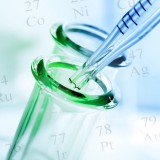Experimental research
Many laboratory studies have shown ultra-high dilution homeopathic medicines having biological effects. Here we present some of the highest quality and most replicated experiments:
Basophil degranulation experiment
28 scientific papers have been published on this topic, 23 of which reported positive results. 11 publications were judged to be of high quality, of which 8 reported positive results.1
The earliest study using this model reported inhibition of degranulation with ultra-molecular dilutions of anti-IgE,2 but these experiments proved to be unreproducible.3,4 However, subsequent studies using a modified method (using ultra-molecular dilutions of histamine instead of anti-IgE), have shown positive results. These findings have been reproduced in several independent laboratories,5,6 as well as in a multi-centre series of experiments.7
Effects of homeopathic thyroxine on tadpole development
In amphibians, the hormone thyroxine stimulates metamorphosis. Over almost 20 years, various teams have tested homeopathic dilutions of thyroxine on frogs by adding it to the bathing water tadpoles are kept in.
Although exact results varied, 20/22 experiments have found the same trend – that Thyroxine 30x (diluted beyond Avogadro’s limit using the homeopathic manufacturing process) inhibits metamorphosis.
The challenge of reproducibility
Although these laboratory studies demonstrate that homeopathic medicines can exert biological effects, so far no positive result has been stable enough to be reproduced by all researchers every time. Close to 75% of in vitro experiments on ultra-high dilutions show the substance having an effect, and nearly 75% of replications have been positive.1
As scientists gain more experience experimenting on ultra-high dilutions, they are gradually understanding what factors are influencing the results and consequently, reproducibility is improving 9. The basophil and frog experiments described above have proved the most repeatable so far and progress is also being made in finding the most repeatable plant-based experiments.
However, until an experiment is achieved in which every team gets exactly the same effect every time, this field will remain controversial. This is the ongoing challenge for basic science researchers in homeopathy.
Dr Stephan Baumgartner, University of Bern, Swtizerland
Ground-breaking work testing homeopathic medicines on plants:
and the rapid progress being made by those at the cutting edge of basic research in homeopathy:
- Witt CM, Bluth M, Albrecht H, Weisshuhn TE, Baumgartner S, Willich SN. The in vitro evidence for an effect of high homeopathic potencies–a systematic review of the literature. Complement Ther Med., 2007; 15(2):128-38 | PubMed
- Davenas E, Beauvais F, Amara J, et al. Human basophil de-granulation triggered by very dilute antiserum against IgE. Nature, 1988; 333: 816–818 | PubMed
- Ovelgönne JH, Bol AW, Hop WC, van Wijk R. Mechanical agitation of very dilute antiserum against IgE has no effect on basophil staining properties. Experientia, 1992; 48: 504–508 | PubMed
- Hirst SJ, Hayes NA, Burridge J, et al. Human basophil degranulation is not triggered by very dilute antiserum against human IgE. Nature, 1993; 366: 525–527 | PubMed
- Belon P, Cumps J, Ennis M, et al. Inhibition of human basophil degranulation by successive histamine dilutions: results of a European multi-centre trial. Inflammation Research, 1999; 48 (Suppl 1): S17–18 | PubMed
- Lorenz I, Schneider EM, Stolz P, et al. Sensitive flow cytometric method to test basophil activation influenced by homeopathic histamine dilution. Forschende Komplementärmedizin, 2003; 10: 316–324 | PubMed
- Belon P, Cumps J, Ennis M, et al. Histamine dilutions modulate basophil activation. Inflammation Research, 2004; 53: 181–188 | PubMed
- Harrer B. Replication of an experiment on extremely diluted thyroxine and highland amphibians. Homeopathy, 2013; 102(1):25-303 | PubMed
- Endler P, Thieves K, Reich C, Matthiessen P, Bonamin L, Scherr C, Baumgartner S. Repetitions of fundamental research models for homeopathically prepared dilutions beyond 10(-23): a bibliometric study. Homeopathy, 2010; 99(1):25-36 | PubMed | HRI Synopsis





